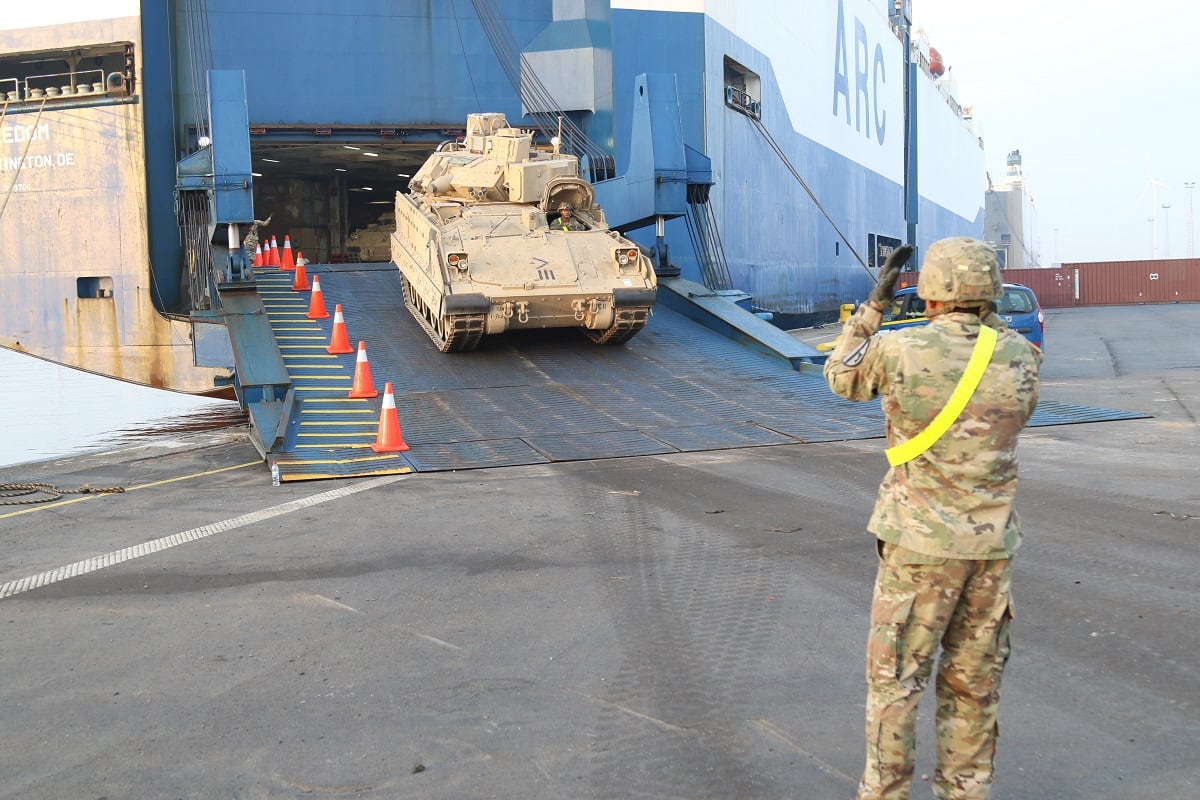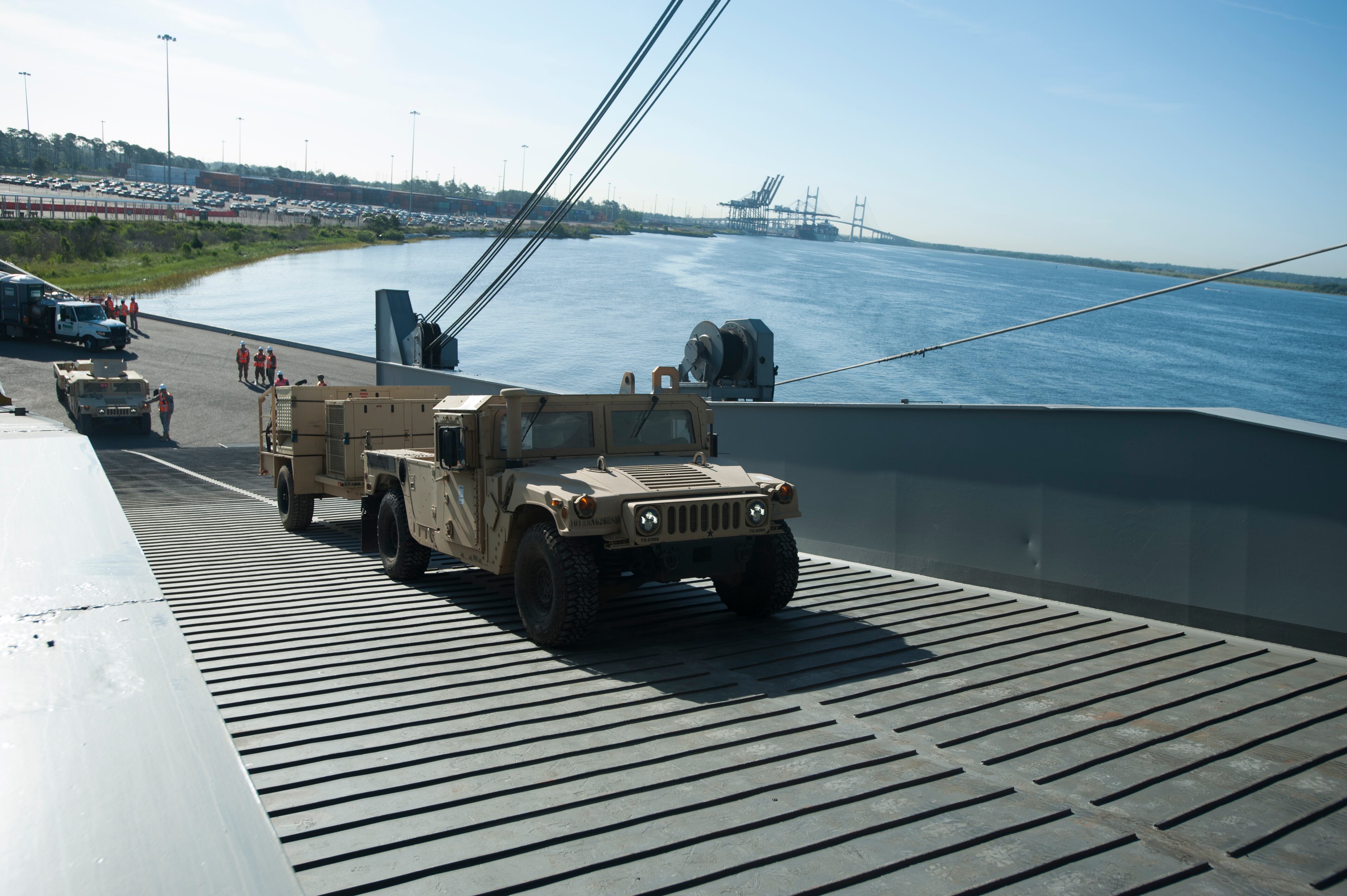OVER THE ATLANTIC OCEAN — The U.S. surge sealift fleet, the ships needed to help transport up to 90 percent of the Army’s and Marine Corps’ gear by sea if the U.S. had to fight a war against a great power, will be facing a full-blown modernization crisis by the end of the 2020s if the Navy can’t arrest its decline, according to a Navy report sent to Congress earlier this year.
The sealift fleet, already hampered by rising maintenance costs and personnel shortages, will begin to dip below what the Defense Department has determined is its required capacity starting in the early 2020s. But the force will start a precipitous decline as the bulk of the Ready Reserve Force ships hit their 50-year service lives starting in 2028.
That date corresponds to the expected nadir of the U.S. Navy’s attack submarine fleet, when the retirement of the Los Angeles-class boats drops the overall number of attack boats from today’s 52 to only 42 subs.
The shortfall in surge sealift ships, combined with a shortage of Navy surface ships to escort them and subs to watch their back, will rapidly create a dire situation for the Department of Defense. And while Defense Secretary Jim Mattis’ DoD pours money into making the force more lethal, by the end of the 2020s it will face the prospect of cascading down a sealift capacity cliff that will leave the U.S without the capacity to bring its more lethal capabilities to bear.
RELATED

Study after study conducted from 1992 through 2013 shows the DoD requirement for government-owned sealift capacity is 15.3 million square feet, with 19.6 million square feet needed overall, the extra capacity coming from 60 U.S.-flagged commercial ships in the Maritime Security Program available to the military in a crisis.
Those government-owned ships include 26 Military Sealift Command pre-positioning ships, 46 ships in the Ready Reserve Force and 15 MSC-owned roll-on/roll-off surge force ships. Many of the ships in the Ready Reserve Force run on obsolete steam propulsion, which has created severe manning issues for the Maritime Administration, which runs the force.
A Navy report sent to Congress in March, titled “Sealift That the Nation Needs,” shows that if the issue isn’t addressed soon, the force falls to about 12 million square feet of sealift capacity by 2030 and somewhere around 7.5 million square feet of capacity by 2035, less than half the sealift required.
And while the timeline may seem long, the mountain of modernization bills facing the Navy and looming cuts to the recently expanded defense budget could cause the military to kick the can down the road as it wrestles with how to arrest the decline of one of its most important strategic assets.
The plan
In order to offset the coming crisis, the Navy and the Maritime Administration came up with a three-pronged approach, according to the Navy’s report: buy used ships off the open market and retrofit them for DoD purposes; buy a new class of ship known as the Common Hull Auxiliary Multi-Mission Platform, or CHAMP, if they can make the concept work; and perform service-life extensions on ships the Navy thinks could benefit from them.
Over the next five years, the Navy has programmed about $242.4 million for the recapitalization program, according to the report, a number that will have to go up to meet an accelerated timeline mandated by Congress in this year’s National Defense Authorization Act.
The Navy plans 31 service-life extensions across the Maritime Administration and MSC surge fleet, according to the report. But that would mean when those ships leave service they will be close to collecting Social Security, raising the hull life from 50 to 60 years. That comes with a whole basket of issues, the report said.
“Extending service life of vessels is a temporary mitigation as the fleet’s average age will continue to increase,” the report reads. “This exacerbates the challenge of maintaining older vessels with obsolete equipment and scarce spare parts.”
In 2017, the Government Accountability Office documented a significant spike in the number of mission-limiting casualties in surge sealift ships, hampering availability and causing maintenance availabilities to run long, all of which costs money.
The refitting of those ships is also a big chunk of change. The Navy estimates it will run about $147.4 million over the next five years.
Congress moved out this year on another part of the strategy: buying used ships. All told, the Navy estimates it will need 26 used commercial ships to maintain the 15.3 million-square-foot requirement.
The market for such ships is plentiful, according to the Navy report. A December request for information from the Maritime Administration turned up 64 ships that could be acquired, meaning the DoD will have its pick of the litter.
In the 2018 and 2019 National Defense Authorization Act, Congress freed up authorization for the Defense Department to buy up to seven commercial ships, built anywhere in the world, that could recapitalize the Ready Reserve Force.
The kicker, however, is that Congress wants the secretary of the Navy, prior to purchasing more than two of the new ships, to submit a plan for a new class of new-build sealift ships.
“In order to procure more than two such vessels, the secretary would need to certify that the U.S. Navy has initiated an acquisition strategy for the construction of no fewer than 10 new sealift vessels, with the lead ship anticipated to be delivered by not later than 2026,” according to the 2019 NDAA explanatory statement released by Congress.
To CHAMP or not to CHAMP
That brings the plan around to the most expensive option in the short term for forestalling the sealift cliff: buying new. In September, the Navy issued an RFI for CHAMP prefatory to acting Congress’ direction to have a ship delivered by 2026.
The Navy thinks it can have a new logistics ship ordered by 2023 if Congress ponies up the cash, according to the Navy report.
The idea behind CHAMP is to combine five different kind of sealift ships into one common hull, getting some savings out of commonality. But after getting back some results, the Navy is starting to think that may not be the right option, Inside Defense reported Oct. 19.
"What we've figured out is that mission set is very broad," Capt. Scot Searles, strategic sealift and theater sealift program manager, said at a recent expeditionary warfare conference, Inside Defense reported.
“The missions the Navy wants CHAMP to address include strategic sealift, aviation intermediate maintenance support, medical services, command and control, and submarine tending. We have some early returns from some of the investigations we’ve done so far that [say] a single hull doesn’t make sense, and so we want to make sure we’re investigating and not trying to predisposition the answer," Searles said.
RELATED

But if CHAMP isn’t the right answer, the Navy is going to have to quickly come up with something to meet Congress’ timeline, not to mention forestall a serious drop in sealift capacity.
And all of this will still have to face the Pentagon wars, with the White House signaling that the Defense Department may take a cut in funding next year. If times get tight, as it seems likely they will, the Navy may fall back on buying its big-ticket destroyers, submarines and follow-on frigates, said Bryan McGrath, a retired destroyer skipper who runs the defense consultancy The FerryBridge Group.
“There are lots of signals that you can send that you are serious about preparing for great power war,” McGrath said. “The bang for the buck you get for force closure — that is, the ability to get your forces to the fight — is outsized. It’s considerable.
“When you are able to demonstrate you have the ability to move the ground forces you need, in the time you need, depriving the adversary its natural advantages gained from proximity to the battlefield — that is a signal. And, relatively speaking, it’s a signal you can send at not much cost.”
David B. Larter was the naval warfare reporter for Defense News.






